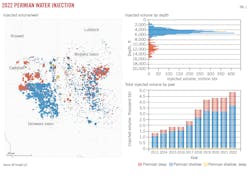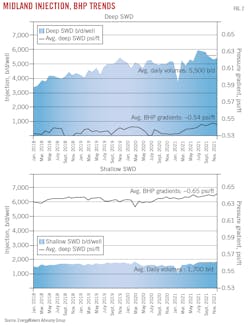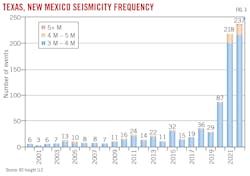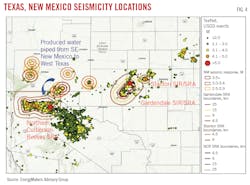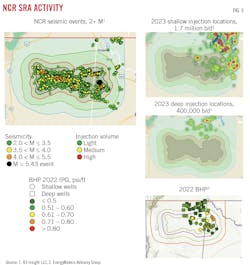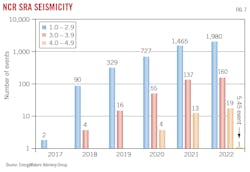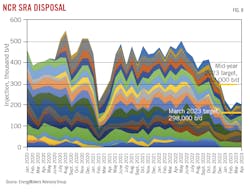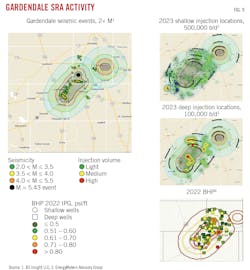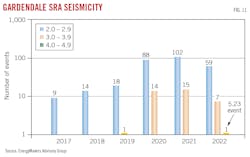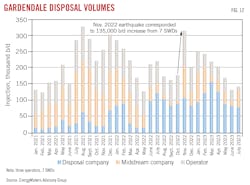Permian SWD’s seismic effects remain only partially understood
Seismic events in the Permian basin have prompted the Railroad Commission of Texas (RRC) to restrict deep salt-water disposal (SWD) and instead direct injection towards shallow zones based on epicenter locations. SWD-seismic injection relationships, however, are not fully understood and appear to differ depending upon the area. For example, seismicity appears correlated with injection volumes in the Gardendale seismic response area (SRA) around Midland, but seismicity is better correlated with pressure regimes in the Northern Culberson-Reeves (NCR) SRA near the southern New Mexico-Texas border.
Driving injection from deep zones into shallow zones, however, may not solve seismicity issues and could overpressurize shallow zones, damaging aging oil and gas infrastructure and threatening protected aquifers.
Permian basin injection
Over the past 10 years, more than 30 billion bbl of water has been injected into the Permian basin. Up to 17 billion bbl has been injected into shallow zones in Delaware basin (DB), and about 8.9 billion bbl into Midland basin (MB). By contrast, only about 3.8 billion bbl have been injected deep in DB and 4.5 billion bbl in MB.
Seismicity has been increasing in the basin over this time, and in 2020 the RRC implemented water injection restrictions in specific seismically active areas, even though there was no direct basin-wide correlation between SWD and seismicity. SWD injection has subsequently been reduced by about 50% for shallow and moderately shallow wells, and up to 90% in deep injection wells in these areas.
Seismicity is not the only concern about SWD, and increasing shallow injection to make up for the loss of deep injection may cause other problems such as abandoned wells losing isolation and discharging to the surface, or subsurface reinjection into aquifers or other zones. Shallow zone overpressurization will also make drilling more difficult.
Fig. 1 shows both substantial shallow and deep disposal south of the Texas-New Mexico border and relatively minor disposal in New Mexico. This difference reflects the disparity in regulatory actions between the two states, with easier and faster permitting for shallow wells in Texas, a moratorium on shallow disposal in New Mexico, and lower deep-well drilling costs in Texas. Currently, about 1.6 million b/d of New Mexico produced water is being sent to Texas for disposal.
All Class II injection wells require periodic reporting of injection volume and surface pressures. Standard reporting (in areas without excessive seismic activity) requires only monthly monitoring, but data are uploaded yearly, meaning that relevant field information is typically 12 months behind current events.
The data show that at least one-third of Permian basin disposal wells have been losing injection capacity since 2016 based on rising pressures, and some shallow injectors show injection pressures approaching allowable injection limits.
Permian basin seismicity
An SIR is designated by the RRC “to facilitate data gathering, organization, and analysis in an area in which seismic activity is increasing and has, or may lead to, a single seismic event of significance (SES).” An SES is a seismic event of magnitude (M) greater than or equal to 3.5 as determined by the United States Geological Survey (USGS) or the Texas Seismological Network and Seismology Research (TexNet). An SIR may be established following an SES or following an increase in the number or magnitude of seismic events, suggesting an increasing seismicity hazard in the area.
Once an SIR is established, the RRC will identify all SWD wells in the SIR and require the operator to provide daily injection volume and surface injection pressures, in contrast to standard monthly monitoring outside an SIR or SRA.
RRC will inspect SWD wells in the SIR and review recent well completion, stimulation, and flowback activities that may relate to recent seismicity. A sub region of the SIR can be designated an SRA if the RRC deems that response actions are required to reduce the probability or prevent the occurrence of an SES. These actions can include rate restrictions on current injection, restrictions on new injection, and expanded reporting requirements to proactively restrict new earthquake activity.
While conclusive science is lacking and research is still early, regulators assume that deep injection is more likely to cause earthquakes. The RRC has, therefore, directed industry to restrict deep injection and instead increase injection into shallow formations.
For example, on Sept. 24, 2021, RRC issued a restriction on SWD injection in the Gardendale SRA to 10,000 b/d per well in permitted SWD wells based on increasing seismic activity. Further, RRC prohibited injection into SWD wells drilled but not yet in service and did not approve permits for new SWD within the SRA. These restrictions cut Midland basin’s permitted disposal capacity by 90% in deep injection wells (OGJ, Dec. 6, 2021, pp. 38-43).
In the NCR SRA, the RRC declared that SWD well injection is a likely contributor to seismicity and restricted injection rates by an average of 54% (ranging from 25% to 88%, depending upon the well). New restrictions have since been implemented in both SRAs based on recent seismicity.
Regardless of area, analysis of EnergyMaker’s BHP trends raises concerns over actions which assume shallow injection as the safer alternative without full understanding of seismic-SWD injection relationships. This assumption encourages operators to restrict deep injection in favor of shallow formations. Injection into already over pressurized shallow zones which may overlap aging oil and gas infrastructure and are proximal to protected aquifers risks SWD isolation, potentially threatening freshwater aquifers, which SWD is otherwise designed to protect.
NCR SRA
The black area covers the 4.5-km SRA. It has the same deep-well restrictions as above but further restrictions to shallow injection. A 10,000-b/d maximum injection restriction was implemented effective September 2022. Operators have the option to add a seismic monitoring station to allow 5,000 b/d of additional injection. Since December 2022, if a 4.5+ M earthquake occurs, wells must cut utilization by 50% for 18 months.
Fig. 6 shows BHP with respect to injection volumes. Pressure gradient trends generally follow injection volume trends within several months. Based on BHP in Fig. 5 and pressure trends in Fig. 6, pressures increased to 0.50 psi/ft average for deep and 0.60 psi/ft average for shallow injection, which does not suggest that significant pressure excursions formed in the SRA. Deep pressure gradients have decreased over time while shallow pressure gradients fluctuated from about 0.60 psi/ft to a maximum of 0.64 psi/ft in Nov. 2021 before descending back towards 0.60 psi/ft.
In November 2022 a 5.43 M earthquake struck the NCR SRA. It followed the typically observed seismic trend of increasing earthquake frequency with relatively constant ratio of large-to-small quakes, both of which are evident in Fig. 7. Deep injection was subsequently restricted to 298,000 b/d. With this additional injection restriction deep volumes are pressuring up, but remain within reasonable pressure ranges surrounding 0.50 psi/ft, compared with typical local fracture pressure ranges of 0.70-0.80 psi/ft or higher.
Hennings et al. claim that the primary cause of fault rupture and seismicity in the Delaware Mountain Group (DMG) in the NCR SRA is minor pressure increases (ΔPp) from SWD. DMG is bounded in the north by the Northwest Shelf, in the west by the Diablo Platform, and in the east by the Central Basin Platform (CBP), which separates it from Midland basin.
The study states that “the majority of the earthquakes that have occurred along deeper BR faults are concentrated in the western part of the basin, especially in the Culberson–Mentone earthquake zone…the most plausible causal agent for earthquake inducement in this area is ΔPp from SWD into strata above basement—principally units of Devonian. Our DFSP analysis indicates that rupture of many faults in this area can occur with very small ΔPp.”
Following this work, a pore pressure modeling study for SWD in the DMG by the University of Texas at Austin modelled BHP from 1983 to 2020. The results show 100-400 psi increases in pore pressure with 500 psi increases near some injection sites. This pressure is enough to laterally grow and connect faults, leading to active faulting. The southern part of DMG has more faulting than the north, therefore the study concluded that shallow SWD in southcentral DB is the primary driver inducing earthquakes (OGJ, Oct. 3, 2022, pp. 22-27).
Regardless of actual seismicity mechanism, further restrictions put in place based on current seismic interpretation reduced deep injection to 162,000 b/d by mid-2023, taking 338,000 b/d off market and requiring the water to go elsewhere (Fig. 8). For context, in 2022 about 1.9 million b/d came across the border from New Mexico for disposal according to EnergyMakers and the New Mexico Produced Water Consortium. By contrast, shallow injection has been maintained at about 700,000 b/d since 2020. Shallow disposal restrictions are not hindering active injection volumes into this region.
Gardendale SRA
Fig. 9 shows the Gardendale SRA seismic events, injection, and BHP. The blue area represents the 25-km SIR, the green area represents the 15-km SRA, the red area outlines the 9-km SRA, and the black area covers the 4.5-km SRA.
Injection from these wells increased about 135,000 b/d within a month and may have altered the local pressure regime. As a result, regulators have further restricted deep-injected volumes and operators are recompleting deep injectors for shallow injection. This will result in a doubling of shallow injection volumes, and if this continues, BHP and surface injection pressure will subsequently increase.
Future Permian basin SWD
In February 2023, the RRC sent a notice to oil and gas operators in the Permian basin requiring that certain new disposal wells be equipped and operated with a bottomhole pressure monitoring gauge. These permit conditions will apply to all new deep-disposal wells and new shallow-disposal wells within an SRA. Permits require that well operators report daily injection data monthly. The reports include the following parameters available via the TexNet injection volume reporting tool:
- Maximum surface injection pressure.
- Average surface injection pressure.
- Maximum bottomhole injection pressure.
- Average bottomhole injection pressure.
- Injection volume.
- Maximum injection rate.
- Average fluid density.
The table lists response plans for the SRAs and details injection restrictions. With these restrictions in place, injection capacity in Texas in 2023 may be reduced as much as 500,000 b/d in the NCR SRA and 400,000 b/d in the Gardendale SRA, depending upon future seismicity.
Future water disposal
With future SWD restrictions and complications associated with pressurizing shallow and deep zones, produced water will require alternative disposal. Recycling water for drilling and completion uses no more than a third of produced water supplies regardless of drilling activity. Converting produced water to freshwater is currently uneconomic and applications for lesser quality water will need to be further exploited. Produced water contains salts and rare earth elements which could yield the economic benefits necessary to drive alternative beneficial reuse.
Bibliography
Capper, L., CEO, “Challenges Related to Beneficial Reuse of Produced Water in the Southwest US,” presentation to the Rocky Mountain American Water Works Association, New Mexico, Mar. 14, 2023.
Capper, L., CEO, EnergyMakers Advisory Group, “Permian Induced Seismicity: Water Balances, Bottom Hole Pressures, and Risk Mitigation,” presentation to the Produced Water Society Seminar, Houston, Tex. Feb. 8, 2023.
Hennings, P., Dvory, N., Horne, E., Li, P., Savvaidis, A., and Zoback, M., “Stability of the Fault Systems That Hose-Induced Earthquakes in the Delaware Basin of West Texas and Southeast New Mexico,” The Seismic Record, Vol. 1, No. 2, Aug. 10, 2021, pp. 96-106.
Patton, P., “Texas is giving away revenue and taking New Mexico’s waste”, Dallas Morning News, Jan. 21, 2023.
Rassenfoss, S., “Permian Operators Squeezed by Growing Water Pressure,” JPT, Feb. 10, 2019.
RRC, “Disposal Well Monitoring and Reporting Requirements in the Permian Basin,” February, 2023.
RRC, “Response Plan to Seismic Events in Texas”, January 2022.
Acknowledgement
The author thanks Laura Capper at EnergyMakers Advisory Group and Rob Bruant at B3 Insight LLC for assistance in assembling this manuscript.
About the Author
Alex Procyk
Upstream Editor
Alex Procyk is Upstream Editor at Oil & Gas Journal. He has also served as a principal technical professional at Halliburton and as a completion engineer at ConocoPhillips. He holds a BS in chemistry (1987) from Kent State University and a PhD in chemistry (1992) from Carnegie Mellon University. He is a member of the Society of Petroleum Engineers (SPE).
